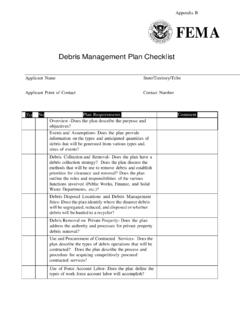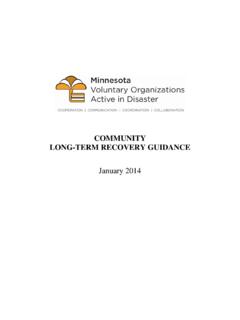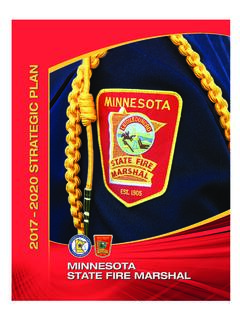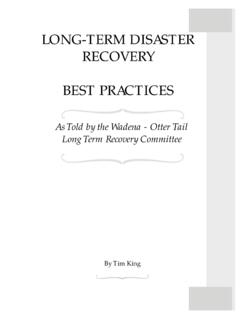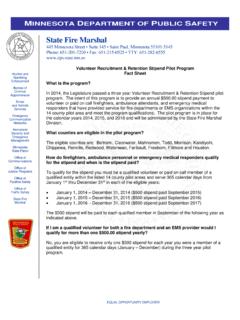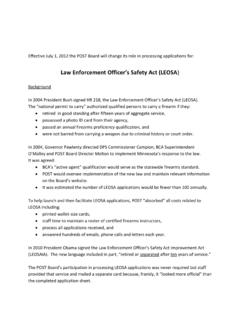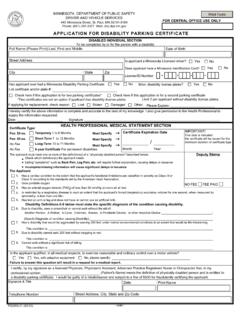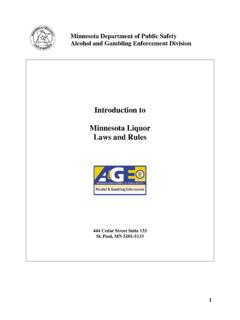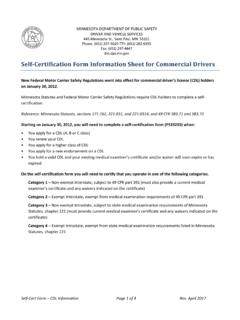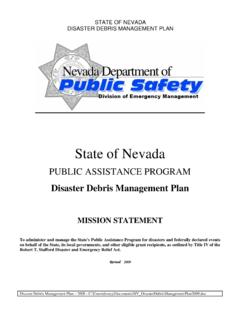Transcription of Debris Management Plan Guidebook
1 Debris Management plan Guidebook A Collaborative Approach to disaster Recovery in minnesota Homeland Security and Emergency Management A Division of minnesota department of public safety 445 minnesota Street, Suite 223 St. Paul, MN 55101-6223 Debris Management plan CHAPTER 1 INTRODUCTION This box will be used to identify the minimum effort that could be undertaken in each of the sections. A thorough plan is best, but don t be overwhelmed and do nothing. Introduction. The purpose of this document is to provide a step-by-step instruction to allow communities to develop a Debris Management plan .
2 Debris removal is one of the first critical recovery activities. This activity is started with little time for preplanning. Costly mistakes can be made if an organized plan is not followed. This guide book is designed to walk you through step by step on creating a Debris Management plan that is right for your community. Overview. Each section identifies what critical items are to be completed, particularly if time is limited. The sections include: Staff roles and Responsibilities Debris Collection Strategy Debris Estimating Debris Management Site Contracted Services Debris Removal on Private Property Mutual Aid Agreements Communications What this template does not include.
3 This template for creating a Debris Management plan does not include details on how to remove Debris but rather how to manage the totality of the removal process. There are a number of good resources (included at the end of each chapter) that provide details on how to create an effective Debris removal plan . To be prepared is half the victory. Miguel de Cervantes (1547-1616) Spanish novelist Resources. At the end of each chapter are forms and links to available resources. An example is also included in the appendices as well as a list of available resources.
4 Personnel involved in preparing a plan . It is recommended that a committee be formed of 6-8 individuals that can meet monthly to develop a plan . This would include a commitment of 4-8 hours between meetings to work on individual assignments. These individuals could include: City staff Elected officials Fire or police chief County emergency manager City consultants public works staff department of Solid Waste MN Pollution Control Local Volunteers The seven month plan . Below is a typical schedule that could be used to create a Debris Management plan .
5 Month 1: Council approval to prepare plan Identify Team. Month 2: First committee meeting Establish monthly meeting times Assign sections Become familiar with reference materials Focus on identifying personnel to be involved and organizational chart. Month 3: Review and confirm organizational chart Status reports on other sections. Research what ordinances or authorities are in place Month 4: Reach consensus on mutual aid agreements needed Reach consensus on Debris recycling information to include in plan Research other Debris removal tasks.
6 Month 5: Review pre-qualified Debris removal contractors Review Mutual Aids for approval Month 6: Complete draft plan for council review. Month 7: Incorporate comments from council Finalize plan City council approval Committee celebration! Good housing practices. The Debris Management plan is only as good as its latest update. Good practices include: Maintain a distribution list and use it to assure all previous versions are replaced when updated. Commit to updating the plan annually.
7 People and phone numbers change. It should be included as a city council agenda item annually to approve the update. Commit to incorporating lessons learned after every Debris removal event and update all applicable sections as needed. Resources: Appendix A: public Assistance Pilot Program Debris Management plan outline. Appendix B: Debris Management Checklist CHECKLIST Chapter 1 Introduction Council approval to form committee Identify committee members Draft plan Finalize plan Council approval Strategy for updating plan Debris Management plan CHAPTER 2 EVENTS AND ASSUMPTIONS If you only have time to do one thing for this section on Events and Assumptions, identify the various events that can happen.
8 Events. We always hear that we were not prepared because this has never happened here before. It is important to list any and all events that might happen in your jurisdiction. The more information gathered during the planning process, the better the recovery efforts will be. After your list is compiled, we will start making assumptions on quantity and types of Debris that will be associated with the event. Tornadoes. Tornadoes usually have a narrow path of Debris . Types of Debris typically associated with tornadoes would be vegetative, construction material from damaged or destroyed structures, and personal property.
9 Floods. Severe thunderstorms, rapid snow melt, and reservoir failure can cause flooding. You can experience inundation or high velocity flooding. Flood Debris may consist of sediment, wreckage, personal property, and sometimes hazardous materials. Lessons Learned: Just what is a Normalcy Bias? It is a mental state that causes people to underestimate both the possibility of a disaster occurring and its possible effects. It s sometimes called the It can t happen here syndrome. The assumption is that since a particular disaster has never occurred before, it never will.
10 Any disturbing indications that something bad may happen are dismissed or trivialized. Fires. Wildfires or urban fires can destroy buildings, vehicles, and vegetation. Debris from fire can consist of ash, charred wood, burnt metals, and burnt personal property. Winter storms. The heavy weight of snow and ice can cause a large Debris issue. Debris may consist of electrical lines, power poles, building materials, and vegetative Debris . Assumptions. Listing the potential Debris that events can produce will help you begin to figure out how you will manage your Debris removal operations.
